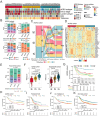Immunotyping the Tumor Microenvironment Reveals Molecular Heterogeneity for Personalized Immunotherapy in Cancer
- PMID: 40433880
- PMCID: PMC12224993
- DOI: 10.1002/advs.202417593
Immunotyping the Tumor Microenvironment Reveals Molecular Heterogeneity for Personalized Immunotherapy in Cancer
Abstract
The tumor microenvironment (TME) significantly influences cancer prognosis and therapeutic outcomes, yet its composition remains highly heterogeneous, and currently, no highly accessible, high-throughput method exists to define it. To address this complexity, the TMEclassifier, a machine-learning tool that classifies cancers into three distinct subtypes: immune Exclusive (IE), immune Suppressive (IS), and immune Activated (IA), is developed. Bulk RNA sequencing categorizes patient samples by TME subtype, and in vivo mouse model validates TME subtype differences and differential responses to immunotherapy. The IE subtype is marked by high stromal cell abundance, associated with aggressive cancer phenotypes. The IS subtype features myeloid-derived suppressor cell infiltration, intensifying immunosuppression. In contrast, the IA subtype, often linked to EBV/MSI, exhibits robust T-cell presence and improved immunotherapy response. Single-cell RNA sequencing is applied to explore TME cellular heterogeneity, and in vivo experiments demonstrate that targeting IL-1 counteracts immunosuppression of IS subtype and markedly improves its responsiveness to immunotherapy. TMEclassifier predictions are validated in this prospective gastric cancer cohort (TIMES-001) and other diverse cohorts. This classifier could effectively stratify patients, guiding personalized immunotherapeutic strategies to enhance precision and overcome resistance.
Keywords: IL‐1; cancer; immunotherapy; immunotyping; tumor microenvironment.
© 2025 The Author(s). Advanced Science published by Wiley‐VCH GmbH.
Conflict of interest statement
The authors declare no conflict of interest.
Figures







References
-
- Shitara K., Ajani J. A., Moehler M., Garrido M., Gallardo C., Shen L., Yamaguchi K., Wyrwicz L., Skoczylas T., Bragagnoli A. C., Liu T., Tehfe M., Elimova E., Bruges R., Zander T., de Azevedo S., Kowalyszyn R., Pazo‐Cid R., Schenker M., Cleary J. M., Yanez P., Feeney K., Karamouzis M. V., Poulart V., Lei M., Xiao H., Kondo K., Li M., Janjigian Y. Y., Nature 2022, 603, 942. - PMC - PubMed
-
- a) Shitara K., Ozguroglu M., Bang Y. J., Di Bartolomeo M., Mandala M., Ryu M. H., Fornaro L., Olesinski T., Caglevic C., Chung H. C., Muro K., Goekkurt E., Mansoor W., McDermott R. S., Shacham‐Shmueli E., Chen X., Mayo C., Kang S. P., A. Ohtsu, C. S. Fuchs, K.‐. investigators , Lancet 2018, 392, 123;
- b) Kang Y. K., Boku N., Satoh T., Ryu M. H., Chao Y., Kato K., Chung H. C., Chen J. S., Muro K., Kang W. K., Yeh K. H., Yoshikawa T., Oh S. C., Bai L. Y., Tamura T., Lee K. W., Hamamoto Y., Kim J. G., Chin K., Oh D. Y., Minashi K., Cho J. Y., Tsuda M., Chen L. T., Lancet 2017, 390, 2461,; - PubMed
- c) Guinney J., Dienstmann R., Wang X., de Reynies A., Schlicker A., Soneson C., Marisa L., Roepman P., Nyamundanda G., Angelino P., Bot B. M., Morris J. S., Simon I. M., Gerster S., Fessler E., De Sousa E. M. F., Missiaglia E., Ramay H., Barras D., Homicsko K., Maru D., Manyam G. C., Broom B., Boige V., Perez‐Villamil B., Laderas T., Salazar R., Gray J. W., Hanahan D., Tabernero J., et al., Nat. Med. 2015, 21, 1350. - PMC - PubMed
-
- Martin‐Serrano M. A., Kepecs B., Torres‐Martin M., Bramel E. R., Haber P. K., Merritt E., Rialdi A., Param N. J., Maeda M., Lindblad K. E., Carter J. K., Barcena‐Varela M., Mazzaferro V., Schwartz M., Affo S., Schwabe R. F., Villanueva A., Guccione E., Friedman S. L., Lujambio A., Tocheva A., Llovet J. M., Thung S. N., Tsankov A. M., Sia D., Gut 2023, 72, 736. - PMC - PubMed
-
- Kirchhammer T. M., der Maur P. A., Läubli H., Zippelius A., Nature 2014, 513, 202
MeSH terms
Grants and funding
- 82404016/National Natural Science Foundation of China
- 82272635/National Natural Science Foundation of China
- 82404087/National Natural Science Foundation of China
- 2023A1515110193/GuangDong Basic and Applied Basic Research Foundation
- 2023A1515011214/GuangDong Basic and Applied Basic Research Foundation
- 2023A1515010208/GuangDong Basic and Applied Basic Research Foundation
- 2024B1212030002/GuangDong Basic and Applied Basic Research Foundation
- 2023A03J0722/Guangzhou Science and Technology Project
- 2023A03J0599/Guangzhou Science and Technology Project
- 202206080011/Guangzhou Science and Technology Project
LinkOut - more resources
Full Text Sources
Medical
